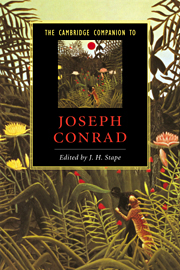2 - The short fiction
Published online by Cambridge University Press: 28 May 2006
Summary
Although his fascination with 'the novel' as a form of art has been well documented by Ford Madox Ford and others, Conrad seldom used the term to refer to his own longer works. In their subtitles, he described six of his novels as 'tales' and one as a 'story', thus emphasizing the older and larger category of narrative fiction. In his letters also, he preferred not to distinguish between short fiction and novels, referring to both forms as 'stories'. This blurring of generic boundaries reflects the organic evolution of many of his works. For example, Nostromo, which he was still calling a 'story' after writing 560 manuscript pages, actually began as a short story before it became a 'long short story', and then a 'long story' or 'novel'. Indeed, any overview of Conrad's creative process would reveal an essentially Darwinian approach to writing fiction in that his art forms are continually being modified by the pressures of their 'environment'. Perhaps for this reason, he often exploited comparisons with elemental or natural forces to describe his working methods: ‘I am letting myself go with the Nigger. He grows and grows’, ‘The Typhoon is still blowing’, ‘Verloc’ – a little earlier called ‘this beast’ – ‘is extending’, ‘Razumov will grow into a short book before I am done with him’, and so on (Letters, I, p. 312; II, p. 307; III, p. 318; IV, p. 76). Of all Conrad‘s stories and novels, only ‘The Lagoon’, an early work of some 6,000 words, conforms to guidelines on length set in advance of composition.
- Type
- Chapter
- Information
- The Cambridge Companion to Joseph Conrad , pp. 25 - 44Publisher: Cambridge University PressPrint publication year: 1996
- 5
- Cited by



